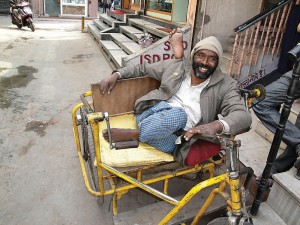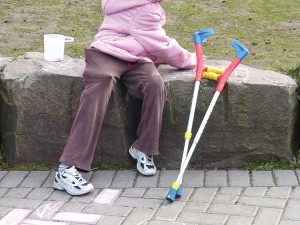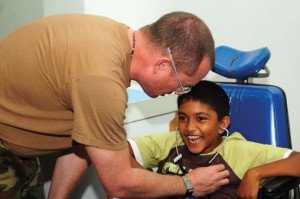While uncovering the plight of the disabled Indian, Nimi Jayachandran suggests the best way for us to shake off our apathetic skin
Introduction
The first thing one would notice about fourteen-year-old Vishal is that he uses a walker, but once you talk to him you would see that he is much like any other child of his age. Vishal is affected by a form of cerebral palsy targeting his motor system hindering his ability to walk. Five years ago, in the early summer of 2009, Vishal was denied access to write the entrance exam to a private school due to his disability. His story is one amongst millions of those discriminated against in our country due to some form of disability.
Defining disability
The official World Health Organization definition of a disability is, “any restriction or lack (resulting from impairment) of ability to perform in a manner or within the range considered normal for a human being.”
The Disability Act of 1995 identifies blindness, low vision, cerebral palsy, leprosy, hearing impairment, motor disability, mental illness and mental retardation as different forms of disabilities. In addition, learning disorders of specific types are considered disabilities as well. There are over 40 million people in India living a life of prejudice and stigma due to some form of disability or the other.
Problems with the definition
It is rather difficult to precisely define what a disability is since it varies in form, type and intensity. Jayna Kothari, founding member of the Centre for Law and Policy Research said in a panel discussion, “[Disability] is changing concept, there is no way to measure it. [We] need an inclusive definition to include all disabilities.” She went on to explain that under the current ruling, a person would have to be at least 40% disabled by medical certification in order to be officially disabled which is not a practical way of determining disability.
Lack of awareness
Poonam Natarajan, Chairperson of the National Trust, explains that the major problem with understanding disabilities in our country is that there is not enough awareness as to how to proceed once the diagnosis of a disability has been made. “34 years ago, when my son was born, I didn’t know whom to speak with and the doctors [weren’t of much help]…no one in our country can really explain to you what the condition is and what it means and what it can do.” When a diagnosis of a disability is made, India has no protocols to help the affected persons and their family. In Western cultures, families are offered counselling services and support groups in order to cope with the situation and to help them understand what life will be like in the years to come. Such services are not as actively found in India. In a panel discussion, Salim Khan of the Being Human Foundation, stated that awareness on psychological disablities is needed just as much as physical disabilities.
Rural problems
Dr. Shweta Solanki, a Project Manager at Anchal Charitable Trust, brings to attention the difference in attitude in rural versus urban societies. “In [rural India], there is less awareness, less quality of education, so [families of disabled people] don’t know how to react.” In many instances, the family members themselves give in to social stigma and pressure and start treating the affected member in a different way. “When going on long trips, family members may feel that taking along the disabled child is a physical burden, and opt to leave them at home instead,” she explains.
Urban stigma
Stigma in society is stronger than most people realise. “Census data may be lower than in reality because many parents are not willing to openly admit that their child has a disability,” says Poonam Natarajan. 26-year-old Abhinand Adithavarman, a Research Scholar at the Bioinformatics Department in SRU Chennai, recollects an incident with a cab driver who refused to drive him. “He said that he would feel like an ambulance driver if he were to drive me around,” he says. Even in today’s modernising society, disabled persons continue to be discriminated against for a plethora of unjustifiable reasons. Society as a whole has a tendency to treat disabled people differently, and not as an equal, regardless of the skills that person may possess.
Insufficient infrastructure
In addition to stigma and discrimination, people dealing with disabilities face problems when it comes to infrastructure. Many places are not equipped with adequate methods of access for them. Access to simple things such as public transport, government offices, public spaces, places of worship and educational institutions are often times restricted to those who do not face the challenge of a disability. Furthermore, the few intervention methods that are taken are generally restricted to physical disabilities only.
Educational facilities
Appropriate education, teaching aids, books in Braille, interpreters for the hearing and speech impaired are still not available for the greater part of those facing disabilities. “When it comes to education, the Right to Education Act has made it so that all schools, by law, must admit children, but we must take into account what happens after the child has been admitted into the school,” says Jayna Kothari. Are there teachers trained to handle students with different needs? Are there interpreters for students who need them? Does the infrastructure of the school provide methods of physical access (such as ramps for wheelchair users)? Once ll these things are taken into account, educational opportunities can no longer be called equal. “When I was in school, the administration took the effort to make sure my classes were on the ground floor and my friends were in the same class as me so they could help me,” says Abhinand, “but only after my father went in and talked to them. You can’t expect all schools to be this way.”
Government efforts
According to the Census 2002, disabled people constitute at least 6% of the total population, yet their individual needs for social security and employment remain unmet. This leaves them at mercy of government aid(s) and society to meet these requirements. The Government of India has certain schemes and facilities to help those affected by disabilities: National Institute for Hearing Handicapped, Disability Act, ADIP Scheme, NHFDC, and various state government schemes. Despite the Disability Act of 1995 having llotted 3% of government sector jobs for these individuals, the implementation of this is not complete. Furthermore, there exists another set of problems in the working area. Abha Thorat-Shah, director of the British Asian Trust, says, “The appropriate facilities need to be provided to disabled people in a workplace, so as to increase their effectiveness.” In addition, employers and staff need to be open minded to working with a person with a disability.
NGO, private and corporate efforts
Private foundations such as the Latika Roy foundation and The Anchal Charitable Trust work to help those affected and to raise awareness. In addition, there are also scholarship opportunities and educational allowances available. Most recently, The Veer Campaign was launched together by Thums Up, the Being Human Foundation and the American Indian Foundation in order to raise awareness and to train people with disabilities to be more modified to a working environment. People interested in contributing to The Veer Campaign may do so by calling 0120-401-9191 or online at https://www.theveer.in
SCHOOLS FOR DISABLED
* Purti Special Education School, Delhi
* Ashray Akruti, Hyderabad
* School for Deaf-Mute Society, Ahmedabad
* Asha Academy for Severe Handicaps and Autism, Bangalore
* Fellowship of the Physically Handicapped, Mumbai
* Bethany Special School, Bangalore
Volume 3 Issue 11































